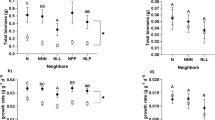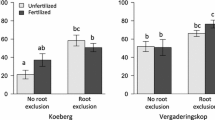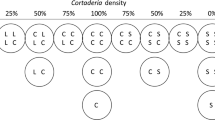Abstract
The success of invasive plants and their impacts on community structure are commonly explained by referring to their supposed higher competitive ability. However, invasive plants do not consistently outperform native species; and the role of competition may also depend on the stage of the invasion process. This study investigated competitive effects of woody alien plant species at an early stage of invasion (Archontophoenix cunninghamiana and Psidium guajava) on closely related New Zealand native species of similar life form (Rhopalostylis sapida and Lophomyrtus bullata, respectively) at several points over time in a shadehouse experiment. Effects of interspecific competition from the paired alien species seedlings on a native seedling were compared to the effects from intraspecific competition of other seedlings of the native species over a 65 week period. Mortality was low throughout the experiment. The native species were affected by density-dependent competition generally, resulting in decreased performance with increasing neighbour density or biomass. The alien palm, A. cunninghamiana, however, had stronger competitive effects on the native palm, R. sapida, than intraspecific competition among R. sapida individuals. Also, P. guajava showed some stronger competitive effects on L. bullata than intraspecific competition among L. bullata individuals. These alien species displayed some traits often associated with invasive plants: A. cunninghamiana had higher RGR, height, biomass production and SLA than R. sapida, while P. guajava had higher SLA than L. bullata. Competitive ability of these newly naturalised species may be an important factor influencing their establishment success and subsequent invasion potential.




Similar content being viewed by others
References
Bengtsson J, Fagerström T, Rydin H (1994) Competition and coexistence in plant communities. Trends Ecol Evol 9:246–250
Burns JH, Winn AA (2006) A comparison of plastic responses to competition by invasive and non-invasive congeners in the Commelinaceae. Biol Invasions 8:797–807
Callaway RM, Walker LR (1997) Competition and facilitation: a synthetic approach to interactions in plant communities. Ecology 78:1958–1965
Christianini AV (2006) Fecundity, dispersal and predation of seeds of Archontophoenix cunninghamiana H. Wendl. & Drude, an invasive palm in the Atlantic forest. Rev Bras Bot 29:587–594
Coomes DA, Allen RB (2007) Effects of size, competition and altitude on tree growth. J Ecol 95:1084–1097
Craine JM (2009) Resource strategies of wild plants. Princeton University Press, Princeton
Craine JM, Dybzinski R (2013) Mechanisms of plant competition for nutrients, water and light. Funct Ecol 27:833–840
Craine JM, Lee WG, Walker S (2006) The context of plant invasions in New Zealand: evolutionary history and novel niches. In: Allen RB, Lee WG (eds) Biological invasions in New Zealand. Springer, Berlin, pp 167–177
Daehler CC (2003) Performance comparisons of co-occurring native and alien invasive plants: implications for conservation and restoration. Annu Rev Ecol Evol Syst 34:183–211
Domènech R, Vilà M (2008) Response of the invader Cortaderia selloana and two coexisting natives to competition and water stress. Biol Invasions 10:903–912
Garcia-Serrano H, Sans FX, Escarré J (2007) Interspecific competition between alien and native congeneric species. Acta Oecol 31:69–78
Gibson DJ, Connolly J, Hartnett DC, Weidenhamer JD (1999) Designs for greenhouse studies of interactions between plants. J Ecol 87:1–16
Goldberg DE, Barton AM (1992) Patterns and consequences of interspecific competition in natural communities: a review of field experiments with plants. Am Nat 139:771–801
Goldberg DE, Landa K (1991) Competitive effect and response: hierarchies and correlated traits in the early stages of competition. J Ecol 79:1013–1030
Goldberg DE, Scheiner SM (2001) ANOVA and ANCOVA. Field competition experiments. In: Scheiner SM, Gurevitch J (eds) Design and analysis of ecological experiments. Oxford University Press, New York, pp 69–93
Grotkopp E, Rejmánek M (2007) High seedling relative growth rate and specific leaf area are traits of invasive species: phylogenetically independent contrasts of woody angiosperms. Am J Bot 94:526–532
Jones DL (1996) Palms in Australia. Reed Books Australia, Melbourne
Kawaletz H, Mölder I, Zerbe S, Annighöfer P, Terwei A, Ammer C (2013) Exotic tree seedlings are much more competitive than natives but show underyielding when growing together. J Plant Ecol 6:305–315
Lamarque LJ, Delzon S, Lortie CJ (2011) Tree invasions: a comparative test of the dominant hypotheses and functional traits. Biol Invasions 13:1969–1989
Levine JM, Vilà M, D’Antonio CM, Dukes JS, Grigulis K, Lavorel S (2003) Mechanisms underlying the impacts of exotic plant invasions. P Roy Soc Lond B Bio 270:775–781
MacDougall AS, Gilbert B, Levine JM (2009) Plant invasions and the niche. J Ecol 97:609–615
Mangla S, Sheley RL, James JJ, Radosevich SR (2011) Intra and interspecific competition among invasive and native species during early stages of plant growth. Plant Ecol 212:531–542
National Institute of Water and Atmospheric Research (2013) Climate. http://www.niwa.co.nz/our-science/climate. Accessed 25 June 2013
Ordonez A, Wright IJ, Olff H (2010) Functional differences between native and alien species: a global-scale comparison. Funct Ecol 24:1353–1361
Ramseier D, Weiner J (2006) Competitive effect is a linear function of neighbour biomass in experimental populations of Kochia scoparia. J Ecol 94:305–309
Randall R (2007) Global compendium of weeds. http://www.hear.org/gcw/. Accessed 21 June 2013
Reich PB, Ellsworth DS, Walters MB (1998) Leaf structure (specific leaf area) modulates photosynthesis-nitrogen relations: evidence from within and across species and functional groups. Funct Ecol 12:948–958
Richardson DM, Rejmánek M (2011) Trees and shrubs as invasive alien species—a global review. Divers Distrib 17:788–809
Schwinning S, Weiner J (1998) Mechanisms determining the degree of size asymmetry in competition among plants. Oecologia 113:447–455
Sheppard CS (2013) How does selection of climate variables affect predictions of species distributions? A case study of three new weeds in New Zealand. Weed Res 53:259–268
Thorpe AS, Aschehoug ET, Atwater DZ, Callaway RM (2011) Interactions among plants and evolution. J Ecol 99:729–740
Tilman D (1982) Resource competition and community structure. Princeton University Press, Princeton
Trinder CJ, Brooker RW, Robinson D (2013) Plant ecology’s guilty little secret: understanding the dynamics of plant competition. Funct Ecol 27:918–929
van Kleunen M, Weber E, Fischer M (2010) A meta-analysis of trait differences between invasive and non-invasive plant species. Ecol Lett 13:235–245
Venables WN, Ripley BD (2002) Modern applied statistics with S. Fourth edition. Springer
Vilà M, Weiner J (2004) Are invasive plant species better competitors than native plant species?—Evidence from pair-wise experiments. Oikos 105:229–238
Vilà M, Espinar JL, Hejda M, Hulme PE, Jarošík V, Maron JL, Pergl J, Schaffner U, Sun Y, Pyšek P (2011) Ecological impacts of invasive alien plants: a meta-analysis of their effects on species, communities and ecosystems. Ecol Lett 14:702–708
Weiner J (1990) Asymmetric competition in plant populations. Trends Ecol Evol 5:360–364
Williams PA (2006) The role of blackbirds (Turdus merula) in weed invasion in New Zealand. New Zeal J Ecol 30:285–291
Acknowledgments
We would like to thank M. Stanley for her input into this study and helpful comments on a draft of this manuscript. We are grateful to L. Buetje, K. Booth, M. Perez and A. Probert for their assistance with harvesting plants. This research was funded by The University of Auckland and Auckland Council.
Author information
Authors and Affiliations
Corresponding author
Additional information
Communicated by R. Ostertag.
Electronic supplementary material
Below is the link to the electronic supplementary material.
Rights and permissions
About this article
Cite this article
Sheppard, C.S., Burns, B.R. Effects of interspecific alien versus intraspecific native competition on growth of native woody plants. Plant Ecol 215, 1527–1538 (2014). https://doi.org/10.1007/s11258-014-0411-2
Received:
Accepted:
Published:
Issue Date:
DOI: https://doi.org/10.1007/s11258-014-0411-2




